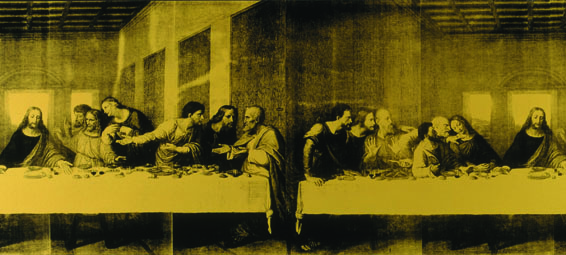Like Duchamp’s bicycle wheel picking up speed downhill, once Andy Warhol got his fame rolling he lost control of the machine.
To this day, mention his name and most people only see the Campbell’s Soup Cans or pastel Marilyns that were cranked out at the Factory just eight years into an almost 30-year career. That’s because long before Valerie Solanas could shoot him in the spleen, Warhol shot himself in the foot, allowing his appetite for celebrity to overcome his gall for making art. But like Hollywood’s best our protagonist finds redemption, right before he croaks, in Andy Warhol: The Last Decade, at the Modern Art Museum of Fort Worth.
Ironic also that the artist would be born again swaddled in canvas after having helped write the obituary for painting. In the Milwaukee Art Museum’s catalog for the exhibition (almost entirely paintings), curator Joseph Ketner records two of Warhol’s revisionisms on the subject, spoken twenty years apart:
![Warhol_Self_Portrait[1]](https://assets.dmagstatic.com/wp-content/uploads/2010/03/Warhol_Self_Portrait1-297x300.jpg)
(1966) “I don’t paint anymore. I gave it up about a year ago and just do the movies now…Painting was just a phase I went through.”
(1985) “I like all paintings; it’s just amazing that it keeps, you know, going on. And the way new things happen and stuff.”
I think the “stuff” Warhol referred to is the Stuff of Art and the Artist’s Life: the exhilaration of new ideas; the longing to be known; weighing the security of solitude against the risk of relationship. His exploration of these themes gets played out, was in fact played out, in The Last Decade. What is revealed is what’s most appealing and true about Warhol himself.
Taking only the theme of new ideas, several are displayed to stunning effect at the Modern. Originally intended to reinvent him as an Abstract Expressionist, these are typical Warholian collaborations that resulted in the most beautiful series represented in the exhibition: the Pollock-like Yarn paintings, the huge Rorschach paintings, and the Oxidation paintings, for which Warhol and his intimates urinated on canvases primed with metallic pigments. These works left the critics wondering how to react, as writing in the New York Times Roberta Smith asked, “Do they express Warhol’s hesitance as a painter, or – equally possible – his underlying disdain for the medium?”
![Warhol_Yarn[1]](https://assets.dmagstatic.com/wp-content/uploads/2010/03/Warhol_Yarn1.jpg)
It’s probably too late for one exhibition to correct a course with the inertia of so many years pushing behind it. To our People Magazine way of looking at art history, Warhol may always be the Prince of Pop and glam-portraitist to the stars. The day I saw it, the bits that seemed to get the most attention from fellow museum visitors were the celebrity-based works mostly included for context, the very works from which he struggled to free himself. Thank goodness he did, finally.
Main image: Andy Warhol, The Last Supper , 1986 (detail). Acrylic and silkscreen on canvas. 78 x 306 in.





